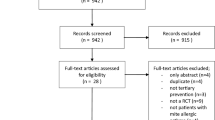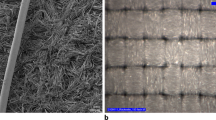Abstract
Asthma is a global health problem with genetic and environmental components. Indoor allergens have a major impact on asthma, and exposure in sensitized subjects can compromise lung function. A reduction in allergen exposure would seem a logical facet to treatment. Methods for reducing mite allergen levels that are effective in the laboratory may not work in the home and may not result in a clinical benefit. Six ongoing studies are investigating the effects of environmental control on the primary prevention of asthma and allergies. Although the Isle of Wight and Canadian studies provide encouraging results at age 8 and 7 years, respectively, it will be some time before a definitive public health message emerges. For secondary prevention, there is little evidence to support the use of mite-proof encasings as a single intervention in adults. In children, however, single or multifaceted interventions appear to be of some benefit.
Similar content being viewed by others
References and Recommended Reading
WHO: Asthma Scope and Burden. http://www.who.int/respiratory/asthma/scope/en/index.html. Accessed February 24, 2006.
Martinez FD: Viruses and atopic sensitization in the first years of life. Am J Respir Crit Care Med 2000, 162:S95-S99.
Alm JS, Swartz J, Lilja G, et al.: Atopy in children of families with an anthroposophic lifestyle. Lancet 1999, 353:1485–1488.
Bjorksten B, Naaber P, Sepp E et al.: The intestinal microfiora in allergic Estonian and Swedish 2-year-old children. Clin Exp Allergy 1999, 29:342–346.
Simpson BM, Custovic A, Simpson A, et al.: NAC Manchester Asthma and Allergy Study (NACMAAS): risk factors for asthma and allergic disorders in adults. Clin Exp Allergy 2001, 31:391–399.
Custovic A, Hallam CL, Simpson BM, et al.: Decreased prevalence of sensitization to cats with high exposure to cat allergen. J Allergy Clin Immunol 2001, 108:537–539.
Braun-Fahrlander C, Riedler J, Herz U, et al.: Environmental exposure to endotoxin and its relation to asthma in school-age children. N Engl J Med 2002, 347:869–877.
Squillace SP, Sporik RB, Rakes G, et al.: Sensitization to dust mites as a dominant risk factor for asthma among adolescents living in central Virginia. Multiple regression analysis of a population-based study. Am J Respir Crit Care Med 1997, 156:1760–1764.
Pollart SM, Chapman MD, Fiocco GP, et al.: Epidemiology of acute asthma: IgE antibodies to common inhalant allergens as a risk factor for emergency room visits. J Allergy Clin Immunol 1989, 83:875–882.
Nelson RP Jr, Di Nicolo R, Fernandez-Caldas E, et al.: Allergen-specific IgE levels and mite allergen exposure in children with acute asthma first seen in an emergency department and in nonasthmatic control subjects. J Allergy Clin Immunol 1996, 98:258–263.
van Strien RT, Verhoeff AP, van Wijnen JH, et al.: Infant respiratory symptoms in relation to mite allergen exposure. Eur Respir J 1996, 9:926–931.
Tan BB, Weald D, Strickland I, et al.: Double-blind controlled trial of effect of housedust-mite allergen avoidance on atopic dermatitis. Lancet 1996, 347:15–18.
Custovic A, Taggart SC, Francis HC, et al.: Exposure to house dust mite allergens and the clinical activity of asthma. J Allergy Clin Immunol 1996, 98:64–72.
Platts-Mills TA, Thomas WR, Aalberse RC, et al.: Dust mite allergens and asthma: report of a second international workshop. J Allergy Clin Immunol 1992, 89:1046–1060.
Gore RB, Durrell B, Bishop S, et al.: High-efficiency vacuum cleaners increase personal mite allergen exposure, but only slightly. Allergy 2006, 61:119–123.
Kroidl RF, Gobel D, Balzer D, et al.: Clinical effects of benzyl benzoate in the prevention of house-dust-mite allergy. Results of a prospective, double-blind, multicenter study. Allergy 1998, 53:435–440.
Simpson A, Simpson B, Custovic A, et al.: Stringent environmental control in pregnancy and early life: the longterm effects on mite, cat and dog allergen. Clin Exp Allergy 2003, 33:1183–1189.
Hide DW, Matthews S, Matthews L, et al.: Effect of allergen avoidance in infancy on allergic manifestations at age two years. J Allergy Clin Immunol 1994, 93:842–846.
Hide DW, Matthews S, Tariq S, et al.: Allergen avoidance in infancy and allergy at 4 years of age. Allergy 1996, 51:89–93.
Arshad SH, Matthews S, Gant C, et al.: Effect of allergen avoidance on development of allergic disorders in infancy. Lancet 1992, 339:1493–1497.
Arshad SH, Bateman B, Matthews SM: Primary prevention of asthma and atopy during childhood by allergen avoidance in infancy: a randomised controlled study. Thorax 2003, 58:489–493. Isle of Wight study showing benefits of primary prevention at age 8 years.
Becker A, Watson W, Ferguson A, et al.: The Canadian asthma primary prevention study: outcomes at 2 years of age. J Allergy Clin Immunol 2004, 113:650–656.
Chan-Yeung M, Ferguson A, Watson W, et al.: The Canadian Childhood Asthma Primary Prevention Study: outcomes at 7 years of age. J Allergy Clin Immunol 2005, 116:49–55. Canadian study showing benefits of primary prevention at age 7 years.
Halmerbauer G, Gartner C, Schierl M, et al.: Study on the Prevention of Allergy in Children in Europe (SPACE): allergic sensitization at 1 year of age in a controlled trial of allergen avoidance from birth. Pediatr Allergy Immunol 2003, 14:10–17.
Horak F Jr, Matthews S, Ihorst G, et al.: Effect of miteimpermeable mattress encasings and an educational package on the development of allergies in a multinational randomized, controlled birth-cohort study—24 months results of the Study of Prevention of Allergy in Children in Europe. Clin Exp Allergy 2004, 34:1220–1225. SPACE study—European primary prevention study showed differences regarding sensitization in first year but failed to detect differences in allergic symptoms at age 2 years.
Brunekreef B, van Strien R, Pronk A, et al.: La mano de DIOS. Was the PIAMA intervention study intervened upon? Allergy 2005, 60:1083–1086.
Koopman LP, van Strien RT, Kerkhof M, et al.: Placebocontrolled trial of house dust mite-impermeable mattress covers: effect on symptoms in early childhood. Am J Respir Crit Care Med 2002, 166:307–313.
Mihrshahi S, Peat JK, Marks GB, et al.: Eighteen-month outcomes of house dust mite avoidance and dietary fatty acid modification in the Childhood Asthma Prevention Study (CAPS). J Allergy Clin Immunol 2003, 111:162–168.
Peat JK, Mihrshahi S, Kemp AS, et al.: Three-year outcomes of dietary fatty acid modification and house dust mite reduction in the Childhood Asthma Prevention Study. J Allergy Clin Immunol 2004, 114:807–813. Australian study showing benefits of mite avoidance and dietary intervention on wheeze at age 18 months—decreased sensitization among intervention group at age 3 years.
Custovic A, Simpson BM, Murray CS, et al.: The National Asthma Campaign Manchester Asthma and Allergy Study. Pediatr Allergy Immunol 2002, 13(Suppl 15):32–37.
Custovic A, Simpson BM, Simpson A, et al.: Manchester Asthma and Allergy Study: low-allergen environment can be achieved and maintained during pregnancy and in early life. J Allergy Clin Immunol 2000, 105:252–258.
Custovic A, Simpson BM, Simpson A, et al.: Effect of environmental manipulation in pregnancy and early life on respiratory symptoms and atopy during first year of life: a randomised trial. Lancet 2001, 358:188–193.
Woodcock A, Lowe LA, Murray CS, et al.: Early life environmental control: effect on symptoms, sensitization, and lung function at age 3 years. Am J Respir Crit Care Med 2004, 170:433–439. MAAS study, a primary prevention study showing benefit on lung functions in mite sensitized 3 year old children.
Cloosterman SG, Schermer TR, Bijl-Hofland ID, et al.: Effects of house dust mite avoidance measures on Der p 1 concentrations and clinical condition of mild adult house dust mite-allergic asthmatic patients, using no inhaled steroids. Clin Exp Allergy 1999, 29:1336–1346.
Woodcock A, Forster L, Matthews E, et al.: Control of exposure to mite allergen and allergen-impermeable bed covers for adults with asthma. N Engl J Med 2003, 349:225–236. The largest double-blind, placebo controlled secondary prevention study in asthmatic adults showing no benefit on clinical outcomes.
Luczynska C, Tredwell E, Smeeton N, Burney P: A randomized controlled trial of mite allergen-impermeable bed covers in adult mite-sensitized asthmatics. Clin Exp Allergy 2003, 33:1648–1653. Secondary prevention study in adult asthmatics failed to demonstrate a beneficial effect of mite avoidance on clinical symptoms.
van den Bemt L, van Knapen L, de Vries MP, et al.: Clinical effectiveness of a mite allergen-impermeable bed-covering system in asthmatic mite-sensitive patients. J Allergy Clin Immunol 2004, 114:858–862.
Gotzsche PC, Johansen HK, Schmidt LM, et al.: House dust mite control measures for asthma. Cochrane Database Syst Rev 2004, 4:CD001187. Recent Cochrane analysis on secondary prevention.
Gotzsche PC, Johansen HK, Burr ML, Hammarquist C: House dust mite control measures for asthma. Cochrane Database Syst Rev 2001, 3:CD001187.
Halken S, Host A, Niklassen U, et al.: Effect of mattress and pillow encasings on children with asthma and house dust mite allergy. J Allergy Clin Immunol 2003, 111:169–176.
Morgan WJ, Crain EF, Gruchalla RS, et al.: Results of a home-based environmental intervention among urban children with asthma. N Engl J Med 2004, 351:1068–1080. A large, multifaceted intervention study in children from lowersocioeconomic group showing benefit of environmental interventionon clinical disease.
Carswell F, Birmingham K, Oliver J, et al.: The respiratory effects of reduction of mite allergen in the bedrooms of asthmatic children—a double-blind controlled trial. Clin Exp Allergy 1996, 26:386–396.
Wood RA, Chapman MD, Adkinson NF, et al.: The effect of cat removal on allergen content in household-dust samples. J Allergy Clin Immunol 1989, 83:730–734.
Custovic A, Green R, Taggart SC, et al.: Domestic allergens in public places. II: Dog (Can f1) and cockroach (Bla g 2) allergens in dust and mite, cat, dog and cockroach allergens in the air in public buildings. Clin Exp Allergy 1996, 26:1246–1252.
Wood RA, Johnson EF, Van Natta ML, et al.: A placebocontrolled trial of a HEPA air cleaner in the treatment of cat allergy. Am J Respir Crit Care Med 1998, 158:115–120.
van der Heide S, van Aalderen WM, Kauffman HF, et al.: Clinical effects of air cleaners in homes of asthmatic children sensitized to pet allergens. J Allergy Clin Immunol 1999, 104:447–451.
Francis H, Fletcher G, Anthony C, et al.: Clinical effects of air filters in homes of asthmatic adults sensitized and exposed to pet allergens. Clin Exp Allergy 2003, 33:101–105.
Author information
Authors and Affiliations
Corresponding author
Rights and permissions
About this article
Cite this article
Jusufagic, A.S., Simpson, A. & Woodcock, A. Dust mite allergen avoidance as a preventive and therapeutic strategy. Curr Allergy Asthma Rep 6, 521–526 (2006). https://doi.org/10.1007/s11882-006-0031-6
Issue Date:
DOI: https://doi.org/10.1007/s11882-006-0031-6




